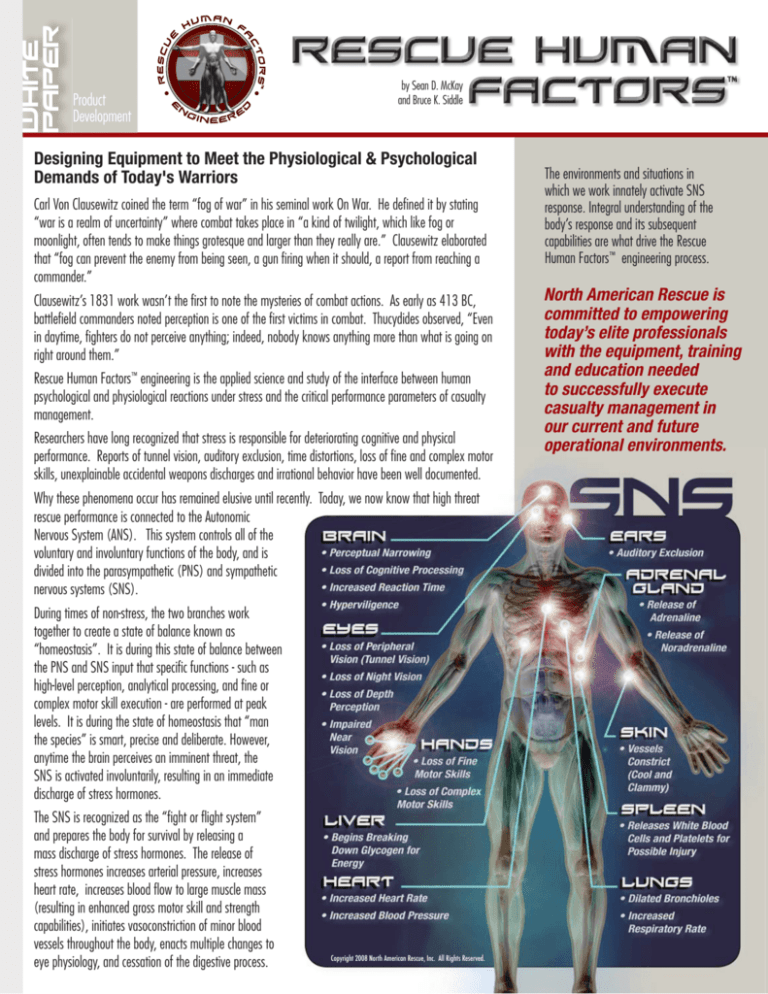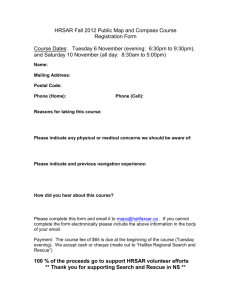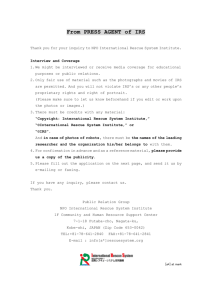
WHITE
PAPER
Product
Development
by Sean D. McKay
and Bruce K. Siddle
Designing Equipment to Meet the Physiological & Psychological
Demands of Today's Warriors
Carl Von Clausewitz coined the term “fog of war” in his seminal work On War. He defined it by stating
“war is a realm of uncertainty” where combat takes place in “a kind of twilight, which like fog or
moonlight, often tends to make things grotesque and larger than they really are.” Clausewitz elaborated
that “fog can prevent the enemy from being seen, a gun firing when it should, a report from reaching a
commander.”
Clausewitz’s 1831 work wasn’t the first to note the mysteries of combat actions. As early as 413 BC,
battlefield commanders noted perception is one of the first victims in combat. Thucydides observed, “Even
in daytime, fighters do not perceive anything; indeed, nobody knows anything more than what is going on
right around them.”
Rescue Human Factors™ engineering is the applied science and study of the interface between human
psychological and physiological reactions under stress and the critical performance parameters of casualty
management.
Researchers have long recognized that stress is responsible for deteriorating cognitive and physical
performance. Reports of tunnel vision, auditory exclusion, time
ime distortions, loss of fine and complex motor
skills, unexplainable accidental weapons discharges and irrational
tional behavior have been well documented.
Why these phenomena occur has remained elusive until recently.
ently. Today, we now know
ow that hi
high
igh tthreat
hrea
eatt
rescue performance is connected to the Autonomic
Nervous System (ANS). This system controls all of the
voluntary and involuntary functions of the body, and is
divided into the parasympathetic (PNS) and sympathetic
nervous systems (SNS).
During times of non-stress, the two branches work
together to create a state of balance known as
“homeostasis”. It is during this state of balance between
the PNS and SNS input that specific functions - such as
high-level perception, analytical processing, and fine or
complex motor skill execution - are performed at peak
levels. It is during the state of homeostasis that “man
the species” is smart, precise and deliberate. However,
anytime the brain perceives an imminent threat, the
SNS is activated involuntarily, resulting in an immediate
discharge of stress hormones.
The SNS is recognized as the “fight or flight system”
and prepares the body for survival by releasing a
mass discharge of stress hormones. The release of
stress hormones increases arterial pressure, increases
heart rate, increases blood flow to large muscle mass
(resulting in enhanced gross motor skill and strength
capabilities), initiates vasoconstriction of minor blood
vessels throughout the body, enacts multiple changes to
eye physiology, and cessation of the digestive process.
Copyright 2008 North American Rescue, Inc. All Rights Reserved.
The environments and situations in
which we work innately activate SNS
response. Integral understanding of the
body’s response and its subsequent
capabilities are what drive the Rescue
Human Factors™ engineering process.
North American Rescue is
committed to empowering
today’s elite professionals
with the equipment, training
and education needed
to successfully execute
casualty management in
our current and future
operational environments.
WHITE
PAPER
by Sean D. McKay and Bruce K. Siddle
The combination of these physiological changes helped early man avoid becoming a meal for another
predator. The activation of the SNS results in man becoming fast, quick and strong – but at a price of
becoming dumb. However, this was not an issue with early man when action was more important to
survival than determining whether the threat was a male or female lion. All early man needed was to
either flee the area or respond with the strength of Samson to kill the threat.
Yet, the skills of rescue personnel center on fundamental hand/eye coordination, high levels of acuity
or accuracy, and a higher level of cognitive processing. For these processes to work optimally, the body
must be in a state of balance (homeostasis). Unfortunately, activation of the SNS is automatic and it
uncontrollably inhibits the PNS.
The implications of SNS dominance is catastrophic to vision, cognitive processing, as well as fine and/
or complex motor skill performance. For example, SNS excitement will cause the loss of near vision; it
disrupts depth perception and collapses the peripheral
field. Also consider that vision is the dominant sense and is the primary sensory source on which the brain
relies in high threat environments. However, if the visual system is feeding impaired information back to
the brain, threat recognition, processing skills, and spatial awareness will be flawed.
The SNS is even more devastating on cognitive processing, which is an extremely efficient and lightning
fast operation in non stress situations (PNS dominance). It is a process that is normally managed by the
cerebral cortex and higher brain functions. But SNS activation inhibits higher brain functions centered in
the cerebral cortex, resulting in a deterioration of threat recognition, response selection and the ability to
communicate complex thoughts. The result is a dramatic increase in survival reaction time.
Finally, all casualty management results in the execution of a motor skill. Typically, all skills can be
segmented into three categories; gross, fine and complex. Unlike other facets of the warrior profession,
virtually every motor skill executed by rescue personnel is a fine or complex (precision) skill set. Almost
one hundred years of research has demonstrated that under SNS excitement, only gross motor skills
are performed optimally. Fine motor skills such as precision-based casualty care (IV/IO access, airway
management, bandaging, etc) all deteriorate when the SNS is activated.
The situational paradigm in which the rescuer’s skill sets reside is that they are needed immediately when
situations become hazardous to life, whether to the casualty, the rescuer, or both. It is then critical that the
techniques, equipment, and training are designed and engineered to improve function and performance at
the point of wounding or the impact is catastrophic.
Casualty management equipment and technology must not only be an extension of the human body, but
also must compliment rescue physiology. Rescue Human Factors™ engineering mitigates many of the
inhibiting variables that occur in high stress situations and empowers the rescuer’s ability to excel under
these physiological and psychological stressors.
References:
I. Ratey, John J. (2001). A User’s Guide to the Brain. New York, New York: Vintage Books
II. Salomone, J.P., & Pons, P.T. (Eds.). (2007). PHTLS Prehospital Life Support (6th ed.).
St. Louis, Missouri: Mosby, Inc.
III. Siddle, Bruce K. (1995). Sharpening the Warriors Edge. Millstadt, Illinois: PPCT Research Publications
IV. Grossman, Dave C., & Christensen, Loren W. (2007). On Combat: The Psychology and Physiology of Deadly Conflict in
War and in Peace. Millstadt, Illinois: PPCT Research Publications
The Rescue Human Factors™(RHF™)
criteria consists of the
following Stop Gates:
Effective: Is the skill or equipment
effective in accomplishing the
desired result? Through an aggressive
preliminary testing process, does it perform as
advertised? Emphasis is placed on exploiting
foundational strengths and weaknesses.
Efficient: Is this skill or equipment
efficient in the area of operation
of its intended use? Based on the
specific area of operation, a skill and/
or equipment requirement list should be
performed. A list of characteristics pertinent
to the environment where the skill and/or
equipment will be utilized must be compiled.
Executable: Will the rescuer have
the capability of performing the
skills or utilizing the equipment
suggested? Having the capability of
accurately predicting the physiological and
psychological effects of survival stress (Rescue
Human Factors™) in the specific area of operation
is the requirement for this consideration. First,
predictable stress levels based on the area of
operation and/or phase of care during application
are identified. Second, the above information
is then utilized to determine technique,
equipment and skill selection. Compatibility
of skill selection to the area of operation
and subsequent sympathetic nervous system
(SNS) response is a critical consideration.
Whenever you see this icon next
to a product from North American
Rescue, it has been specifically
designed and engineered to spec
according to the Rescue Human
™
Factors Stop Gates for effectiveness, efficiency and
executability in its operational environment.
Copyright 2008 North American Rescue, Inc. All Rights Reserved.
Rescue Human Factors is a trademark of North American Rescue, Inc.






